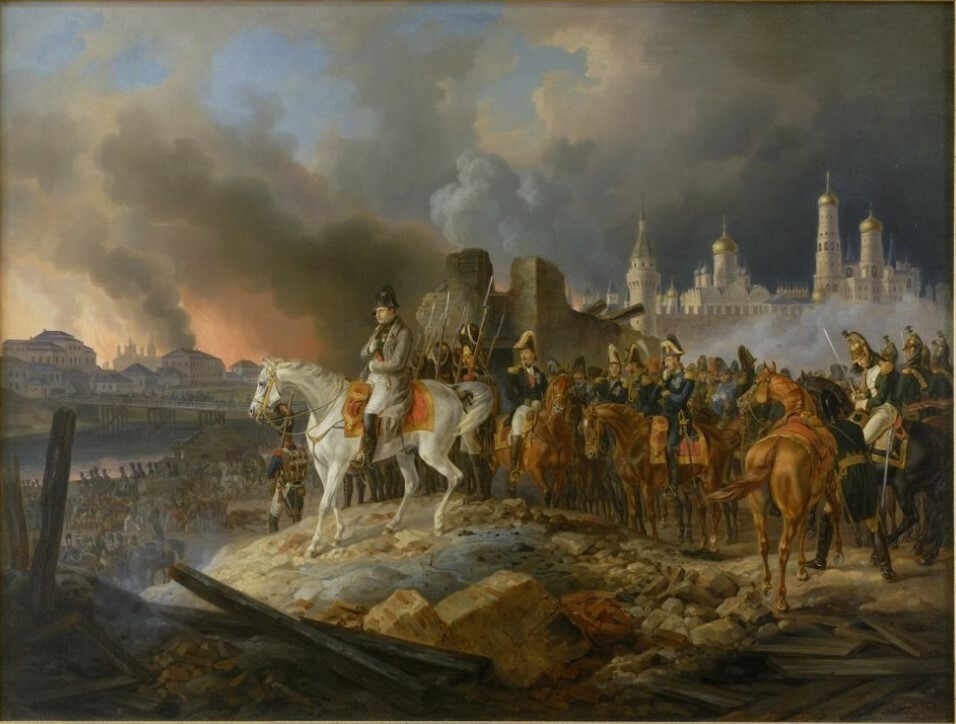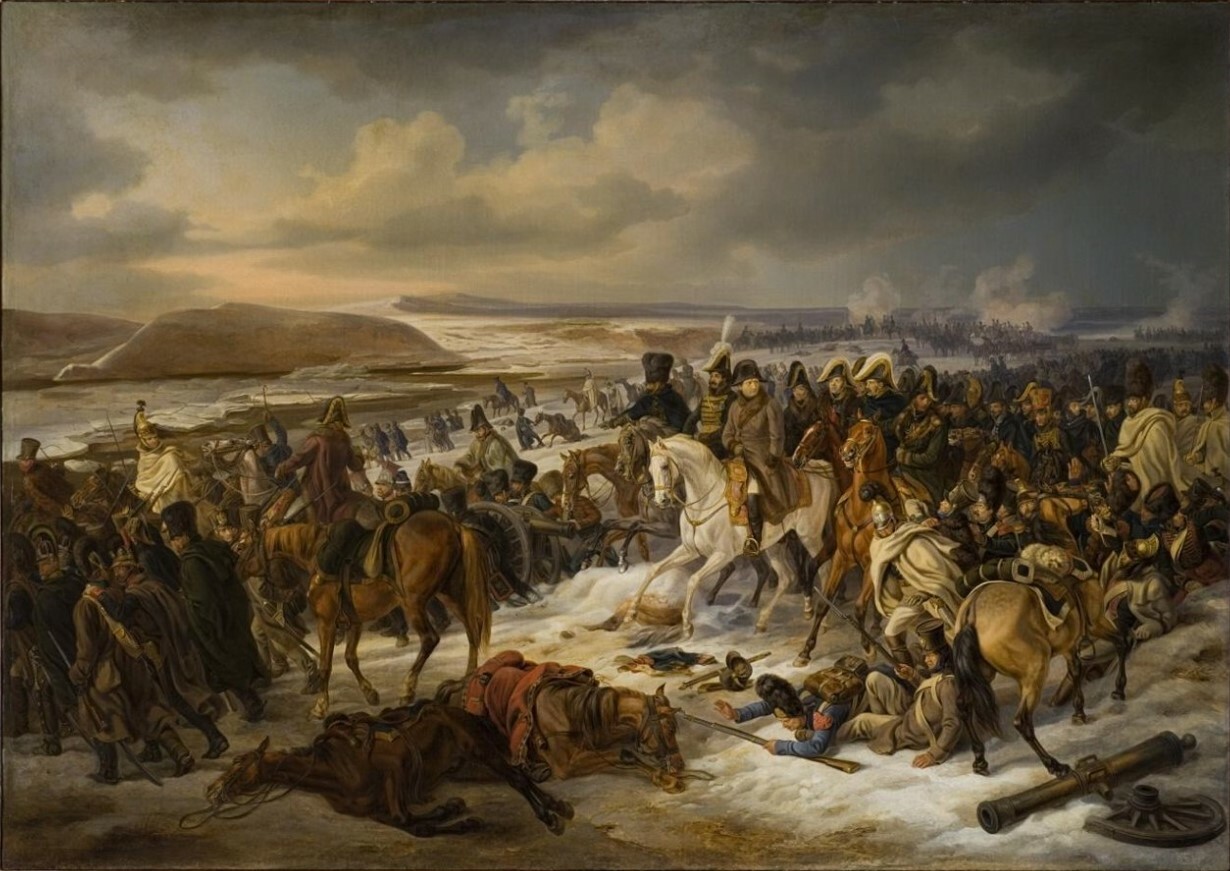paintings of famous
artists
artists
Adam Albrecht
16.04.1786, Nördlingen – 28.08.1862, Munich
Painter, drawing artist drawing artist, engraver and lithographer. Battle, animal painter, and portraitist. He was born into a family of a confectioner and spice merchant. In 1804-1805, he studied at the drawing school in Nuremberg. From 1807, he worked in Munich and attended the Royal Art Gallery. In 1809, he became a court painter of the Vice-king of Italy Eugène de Beauharnais. The same year, he partook in the Napoleon campaign to Russia. He made the way to Moscow and back and witnessed all the battles. He painted battle scenes upon the order of Emperor Nicholas I.


A series of battle compositions based on "The Russian Campaign" of the Napoleon army in 1812-1813s, created by A. Adam
The series includes the following paintings: "The Napoleon Army Crossing the River Berezina", "Emperor Napoleon Departing from the Kremlin", and "The Napoleon Army Retreating from Russia".
A. Adam who entered Moscow with the Napoleon army on 14 September 1812, could have been an immediate witness to the events of 16 September, when Napoleon and his retinue departed from the Kremlin. The indirect evidence of that is the architectural monuments of the Kremlin, depicted in the painting with precise accuracy. On 5 October, A. Adam took a vacation and left Russia.
The sketches from"a picturesque diary" drawn from life together with the impressions of tragic burdens of war that A. Adam got during the Napoleon campaign in 1812 laid the foundation for the paintings, created in Germany. They highlighted the retreat of the Napoleon army from Russia.
The paintings were bought upon the order of Emperor Nicholas I to decorate the imperial palaces. From the mid-19th century, they hung in the imperial cabinet of the Grand Kremlin Palace along with the art pieces of other West-European battle painters, who commemorated the War of 1812.
The paintings came from the Grand Kremlin Palace before 1938.
A. Adam who entered Moscow with the Napoleon army on 14 September 1812, could have been an immediate witness to the events of 16 September, when Napoleon and his retinue departed from the Kremlin. The indirect evidence of that is the architectural monuments of the Kremlin, depicted in the painting with precise accuracy. On 5 October, A. Adam took a vacation and left Russia.
The sketches from"a picturesque diary" drawn from life together with the impressions of tragic burdens of war that A. Adam got during the Napoleon campaign in 1812 laid the foundation for the paintings, created in Germany. They highlighted the retreat of the Napoleon army from Russia.
The paintings were bought upon the order of Emperor Nicholas I to decorate the imperial palaces. From the mid-19th century, they hung in the imperial cabinet of the Grand Kremlin Palace along with the art pieces of other West-European battle painters, who commemorated the War of 1812.
The paintings came from the Grand Kremlin Palace before 1938.
The Napoleon Army Crossing the River Berezina
1830
Oil on canvas
1830
Oil on canvas
The Napoleon Army Retreating from Russia
1841
Oil on canvas
1841
Oil on canvas
Aivazovsky (Aivazian) Ivan (Hovhannes) Konstantinovich
19 July 1817, Feodosiya – 2 May 1900, Feodosiya
Landscape, marine painter, author of paintings themed on the history of the Russian navy and marine battles, antique mythology, the Bible and Gospel. He also painted portraits and city views, worked in drawing techniques using sepia, gouache and watercolour.
Aivazovsky was born in the family of a petty dealer, the elder of the Feodosiya market. He studied in the Imperial Academy of Arts (1833-1839). In 1836, he was awarded with a minor gold medal for the painting "View over the Seacoast near Saint Petersburg". In the summer of 1836, he participated in the sailing of the Baltic Navy ships along the Gulf of Finland. In March 1837, on the order of Emperor Nicholas I, he was assigned to the class of battle painting of Alexander Sauerweid "to practise navy painting". In 1837, he was bestowed a grand gold medal for "three sea views..". In 1838, he was sent to Crimea as a grant holder of the Imperial Academy of Arts to improve his skills. In 1839, he was advanced to a class artist of the first degree and achieved a travel grant for a foreign trip. In 1840, he returned to Saint Petersburg and the same year started off to Italy. He used to live in Rome and travelled many times to Venice, Florence, Naples, and Trieste. He had also visited France, Holland, Belgium, England, Portugal, Spain and Malta during these years. In 1844, he returned to Saint Petersburg on his request, though the grant allowed staying abroad for two years more. The same year he received an honourary degree of academician. In different years (1845, 1846, 1851), Aivazovsky participated in the manoeuvres of the Black Sea and Baltic navies. In 1847, he became a professor at the Imperial Academy of Arts due to the opening of an artistic school entitled "General Workshop" in Feodosiya under his guidance and near his workshop. From 1848, he lived mostly in Feodosiya and travelled or moved to Saint Petersburg only in wintertime. In 1880, he opened an art gallery in Feodosiya and bequeathed all paintings to the city. In 1881, was given the freedom of Feodosiya. Many times he made journeys around Russia and abroad. A member of the council at the Imperial Academy of Arts (1855). From 1887 – an honorary member of the Imperial Academy of Arts. The same year, a medal commemorating Aivazovsky's 50th anniversary of the artistic work was stamped out. He was also an honorary member of several European academies of arts. Starting from 1844, the Russian government was awarding I.K. Aivazovsky with orders and badges of merit on a regular basis.
Aivazovsky was born in the family of a petty dealer, the elder of the Feodosiya market. He studied in the Imperial Academy of Arts (1833-1839). In 1836, he was awarded with a minor gold medal for the painting "View over the Seacoast near Saint Petersburg". In the summer of 1836, he participated in the sailing of the Baltic Navy ships along the Gulf of Finland. In March 1837, on the order of Emperor Nicholas I, he was assigned to the class of battle painting of Alexander Sauerweid "to practise navy painting". In 1837, he was bestowed a grand gold medal for "three sea views..". In 1838, he was sent to Crimea as a grant holder of the Imperial Academy of Arts to improve his skills. In 1839, he was advanced to a class artist of the first degree and achieved a travel grant for a foreign trip. In 1840, he returned to Saint Petersburg and the same year started off to Italy. He used to live in Rome and travelled many times to Venice, Florence, Naples, and Trieste. He had also visited France, Holland, Belgium, England, Portugal, Spain and Malta during these years. In 1844, he returned to Saint Petersburg on his request, though the grant allowed staying abroad for two years more. The same year he received an honourary degree of academician. In different years (1845, 1846, 1851), Aivazovsky participated in the manoeuvres of the Black Sea and Baltic navies. In 1847, he became a professor at the Imperial Academy of Arts due to the opening of an artistic school entitled "General Workshop" in Feodosiya under his guidance and near his workshop. From 1848, he lived mostly in Feodosiya and travelled or moved to Saint Petersburg only in wintertime. In 1880, he opened an art gallery in Feodosiya and bequeathed all paintings to the city. In 1881, was given the freedom of Feodosiya. Many times he made journeys around Russia and abroad. A member of the council at the Imperial Academy of Arts (1855). From 1887 – an honorary member of the Imperial Academy of Arts. The same year, a medal commemorating Aivazovsky's 50th anniversary of the artistic work was stamped out. He was also an honorary member of several European academies of arts. Starting from 1844, the Russian government was awarding I.K. Aivazovsky with orders and badges of merit on a regular basis.

Fire in Moscow in 1812
1851
Oil on canvas
1851
Oil on canvas

Panorama of Moscow with the Cathedral of Christ the Saviour
The second half of the 1800s – early 1810s.
1851
Oil on canvas
The second half of the 1800s – early 1810s.
1851
Oil on canvas
Bagretsov D.P.
The artist is known thanks to his signature on the painting.
There is no information about the artist until the present. Apparently, the author was born in the Bagretsov family of clergy to which belonged church writer L.M. Bagretsov and composer F.A. Bagretsov, precentor at the Chudov Monastery.
There is no information about the artist until the present. Apparently, the author was born in the Bagretsov family of clergy to which belonged church writer L.M. Bagretsov and composer F.A. Bagretsov, precentor at the Chudov Monastery.

Portrait of Hegumene Eugenia (Е.S. Ozerova)
The last third of the 19th c.
Oil on canvas
The last third of the 19th c.
Oil on canvas
Demidov Vasiliy Kuzmich
? – до 1848
Painter of historical subjects, painted genre pieces, icons for church. He served as an artisan in the troop at the Major Headquarters of the Stables Office in the rank of a non-commissioned officer. From 1833, he started attending drawing and painting classes at the Imperial Academy of Arts at the request of Grand Equerry, Prince V.V. Dolgoruky. In 1833, he presented his paintings at the exhibition at the Imperial Academy of Arts. Paintings "Solemn Procession of the Sultan on a Horseback and His Retinue to a Mosque during the Bayram", "Allegory. Peace with Turkey", "Return of a Schoolmiss to Her Family", "Sovereign Showing the Bust of Peter the Great to the Heir" and other works drew the attention of the public and the artists. In 1839, Demidov was declared an academic appointee for the painting "The Last Battle of Yermak".

Redemption of Moscow by Prince Pozharsky and Minin
1836
Oil on canvas
1836
Oil on canvas
Kozlov Gavriil Ignatievich
1738 (?), Moscow – 22.05.1791, Saint Petersburg
Painter of historical subjects, drawing artist. He used to be a bondman of Prince P.F. Tyufyakin. In 1753-1756, he worked under the guidance of A. Peresinotti, P. Gradizzi, G. Valeriani in the Tsarskoe Selo. In 1755, Kozlov was enlisted in the fine arts team of the Construction Office, and from 1760 he became an apprentice. In 1762, he participated in the public exhibition of the Imperial Academy of Arts, where he displayed the painting "Denial of Apostle Peter". After that, he received the title of an adjunct. In 1765, Kozlov became an Academician, and, in 1771, – a Professor of History Painting.
Kozlov created decorations for the court theatre, made drawings for patents and diplomas of the Academy of Arts, for the "Statute on the Raising of Noble Maidens", for order services. In the 1770s, he was working on the sketches of the plafonds for the Grand Kremlin Palace, which was then designed by V.I. Bazhenov. In 1779, Koslov got the post of the Director of Imperial Tapestry Manufacture. Apart from the Academy, he gave lessons in his school.
Kozlov created decorations for the court theatre, made drawings for patents and diplomas of the Academy of Arts, for the "Statute on the Raising of Noble Maidens", for order services. In the 1770s, he was working on the sketches of the plafonds for the Grand Kremlin Palace, which was then designed by V.I. Bazhenov. In 1779, Koslov got the post of the Director of Imperial Tapestry Manufacture. Apart from the Academy, he gave lessons in his school.

Faithful Prince Mikhail of Chernogov in Dormition
1771–1773
Oil on copper
1771–1773
Oil on copper
Möller (von) Fyodor (Otto Friedrich) Antonovich
30 May 1812, Kronstadt – 21 June 1874, Saint Petersburg
Painter, portraitist, drawing artist, painted pictures on historical and genre scenes. He was the son of an Admiral, the former Navy Minister. He began his career as an officer of the Semyonovsky regiment and was an adjutant of the commander of the guards' corps. In his free time, he attended drawing classes at the Imperial Academy of Arts. In 1830, Möller participated in the Polish military campaign. In 1835, still visiting the classes of the Academy, he was awarded the second gold medal for success in drawing. After K.P. Bryullov had returned to Saint Petersburg from abroad, Möller became his student and follower and retired from service. In 1837, he was bestowed a gold medal and the title of academic appointee for the painting depicting his father's family. Then, he travelled abroad at his own expense and in 1840 sent from Rome the painting "A Kiss" to Emperor Nicholas I, who bought it for his private chambers. For this work, Möller received the title of Academician and a grant covering his expenses for two years. He made a new journey around Italy, where he was influenced by J.F. Overbeck and German Pre-Raphaelites who lived in Rome. This is clearly seen in the painting "St John the Evangelist Preaching in the Patmos Island during the Bacchanalia". This painting was presented at the academic exhibition in 1856 and the International Exhibition in London and brought Möller the title of Professor of History Painting and a Cross of St Vladimir.
Series of Paintings about the Deeds of St Alexander Nevsky
It consists of six large-size painted canvases accomplished in the academic style. The series was created in 1862-1866 upon the order of the imperial court for the decoration of St Alexander Hall in the Grand Kremlin Palace that had been erected in the Kremlin in 1849 under the project of Architect K.A. Thon with the participation of F.F. Richter, N.I. Chichagov, V.A. Bakarev, P.A. Gerasimov.
In the Soviet time, the council hall of the Supreme Soviet of the USSR was in the place of St Alexander and St Andrew Halls. After their reconstruction in 1995-1999, six paintings of the series returned to their historical places on the side walls of St Alexander Hall in the Grand Kremlin Palace. Two medallions with the images of Alexander Nevsky in the monastic and princely attires were replaced by copies, made in the late 20th century after the lost originals by F.A. Moller.
In the Soviet time, the council hall of the Supreme Soviet of the USSR was in the place of St Alexander and St Andrew Halls. After their reconstruction in 1995-1999, six paintings of the series returned to their historical places on the side walls of St Alexander Hall in the Grand Kremlin Palace. Two medallions with the images of Alexander Nevsky in the monastic and princely attires were replaced by copies, made in the late 20th century after the lost originals by F.A. Moller.
Sverchkov Nikolay Egorovich
1817, Saint Petersburg – 1898 (?), ibidem
Painter. Painted animals, landscapes, battles, historical and genre scenes. He was born into the family of a staff member of the court stables department. In 1833-1842, he served in the Ministry for Internal Affairs and worked in Khrenovsky and Chesmensky stud farms. At the same time, Sverchkov took an interest in painting and made 'portraits' of famous coursers on the orders of the stud owners. In the 1840s, he entered the Imperial Academy of Arts as a non-collegiate. He created paintings with scenes from the Russian folk's everyday life. In 1852, the Academy of Arts conferred him a degree of academician for the view 'The Trio of Landlord Horses Crossing at Full Tilt the Chain of a Caravan that is Stretching along the Big Road'.Three years later he was awarded the title of a professor for the painting 'Bulky Equipage with Passengers Yoked by Six Exhausted Post Horses Stretching along the Heavy Sand Road on the Hot Summer Day'. Sverchkov accomplished many works with hunting scenes on official and private requests of the royal family members. From 1856, he became popular abroad. He was bestowed an Order of the Legion of Honour for the painting 'Return from the Bear Hunt' displayed at the Paris Salon and later purchased by French Emperor Napoleon III. Sverchkov is the author of numerous large-size canvases themed on Old Russian history. Among them, there are 'Tsar Alexey Mikhailovich with Boyars at the Falcon Hunt near Moscow', 'Bearfighting at the Court of Tsar Ivan the Terrible'. N.E. Sverchkov created around two hundred and forty paintings and more than one thousand drawings and watercolours. Apart from the pictorial art, Sverchkov had a fancy for modelling.

Departure of Tsar Alexey Mikhailovich to Review the Troops in 1664.
1864
Oil on canvas
1864
Oil on canvas

Departure of Tsar Ivan Vasilievich for Pilgrimage
1875
Oil on canvas
1875
Oil on canvas
Svinyn Pavel Petrovich
19 June 1787, Efremovo Manson, Galich Uyezd, Kostroma Governorate – 21 April 1839, (?)
Journalist, publisher, writer, traveller, ethnographer, archaeologist, local lore, collector, drawing and water-colour artist, painter. In 1802, he graduated with a silver medal from the Noble Pension at the Moscow University. In 1805-1806, he served as a registrar in the Moscow Archive of the Foreign Affairs Board. From 8 August 1806 till the end of 1807, he was an interpreter at the military squadron under the leadership of Vice Admiral D.N. Senyavin. Svinyn sailed on the ship 'Raphail' around the Mediterranean Sea. He attended classes at the Imperial Academy of Art. In 1810, he presented two paintings: 'Landscape' and 'Cossacks Leading Two Prisoner Turks'. On 1 September 1811, Svinyn was entitled with the rank 'academician' for the work 'Repose of Count A Suvorov-Rymniksky, Prince of Italy, after the Victory'. Being in Philadelphia until 8 July 1812, he made 78 water-colours with views of America. In 1814-1818, he published several books of travel sketches including 'Memoirs at the Fleet'. On 25 March 1824, upon the highest rescript, he became an honorary member of the Armoury Chamber. He was the one who compiled the first guidebook around the Armoury Chamber – 'The Guide List of Principle Items of Interest Kept in the Workshop and the Armoury Chamber'(1826).
On 26 September 1827, Svinyn was elected the honorary non-collegiate of the Imperial Academy of Arts, he was also a member of the Society of the Russian Literature Amateurs', Free Economic and Mineralogic Societies, from 1833 – member of the Russian Academy of Science.
On 26 September 1827, Svinyn was elected the honorary non-collegiate of the Imperial Academy of Arts, he was also a member of the Society of the Russian Literature Amateurs', Free Economic and Mineralogic Societies, from 1833 – member of the Russian Academy of Science.

View of Syracuse from the Foreside
1811
Oil on canvas
1811
Oil on canvas





